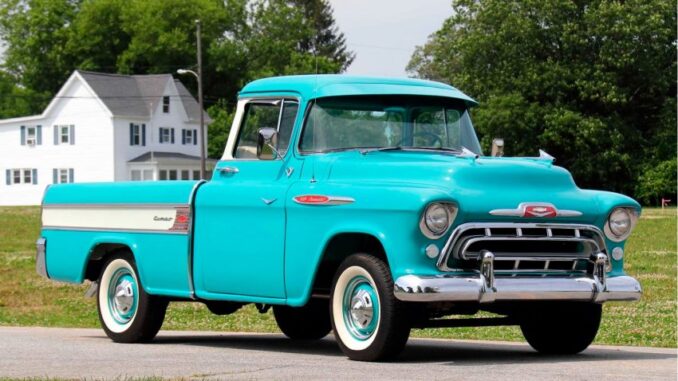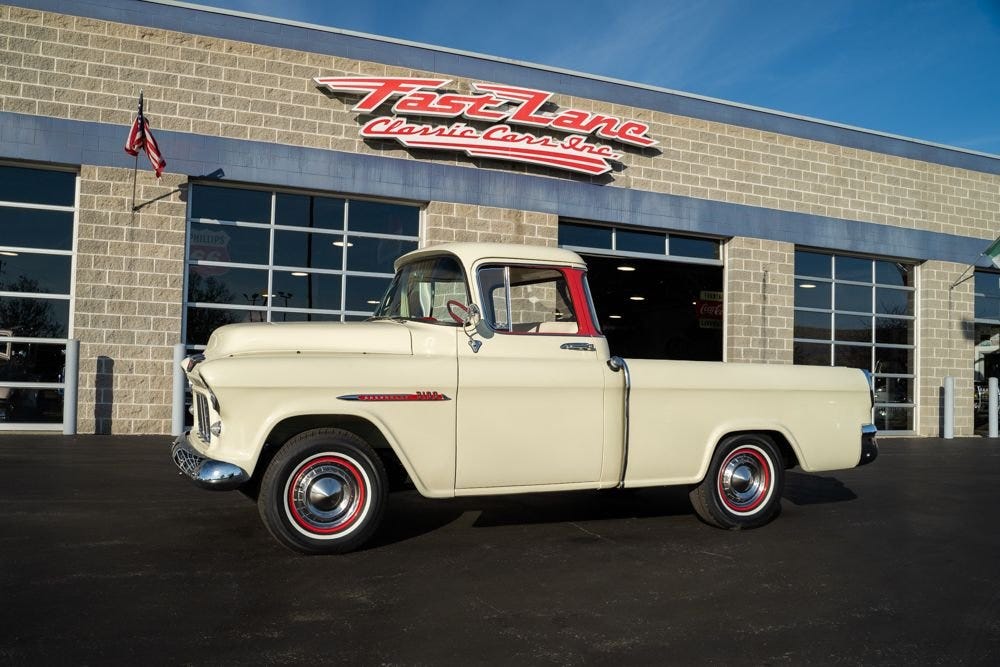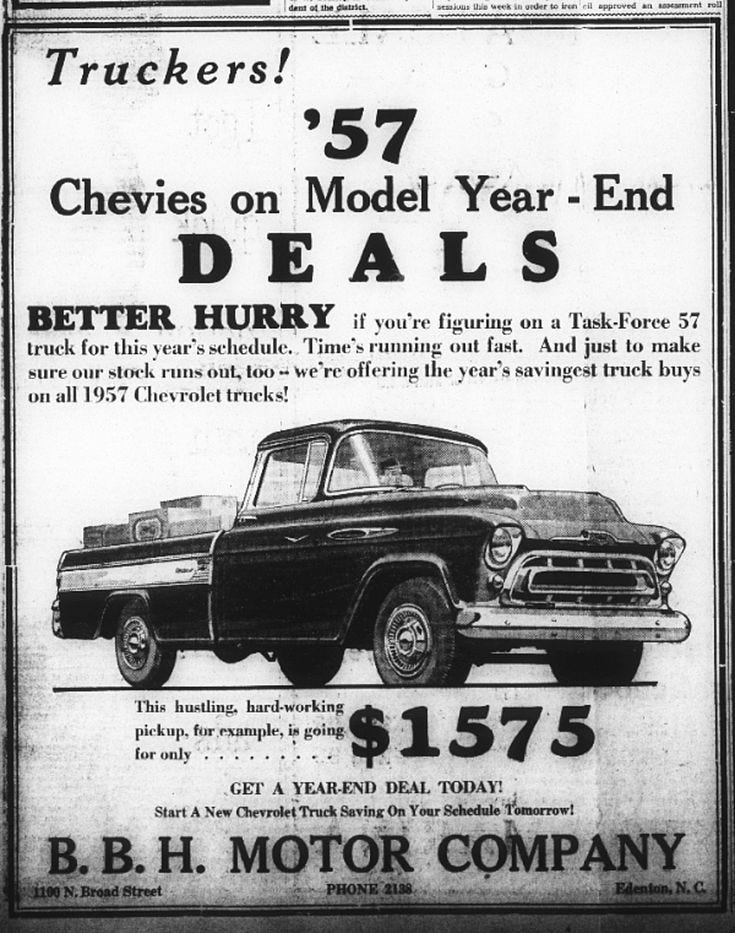
The Chevrolet Cameo is a unique and influential vehicle in American automotive history. Produced from 1955 to 1958, this high-end pickup truck was a radical departure from the rough and utilitarian trucks of its era. It introduced car-like styling and comfort features to the pickup truck market, paving the way for the modern luxury truck segment.
While it wasn’t a massive commercial success, the Cameo left a lasting legacy, inspiring future pickup designs and influencing truck culture.
The Chevrolet Cameo debuted in 1955 as part of Chevrolet’s “Task Force” truck series. Chuck Jordan, Chevrolet’s head of styling, envisioned a pickup that would appeal to suburban buyers rather than just farmers and tradesmen. He designed a smooth-sided pickup with a fiberglass bed, replacing the traditional step-side design. This truck blurred the line between a work vehicle and a stylish second car, making it a predecessor to modern lifestyle trucks like the Ford F-150 Limited and Chevrolet Silverado High Country.
However, the Cameo’s premium price tag—30% higher than a standard Chevrolet truck—limited its appeal. In total, only 10,305 units were sold across its four-year production run, making it a niche vehicle at the time.

The Chevrolet Cameo came with a range of powerful engine options:
- 1955: A 235-cubic-inch straight-six engine producing 123 horsepower.
- Optional Upgrade: A 265-cubic-inch V-8, which improved performance significantly.
- 1957-1958: The Cameo was among the first Chevrolet trucks to feature the 283-cubic-inch V-8, which was later considered one of Chevy’s most iconic engines.
Additionally, the Cameo introduced power steering and power brakes, features uncommon in trucks at the time, making it more comfortable to drive. Some models also offered Hydra-Matic automatic transmission, further enhancing the truck’s luxury appeal.
The Chevrolet Cameo’s design was revolutionary:
- Smooth Fiberglass Rear Fenders: Unlike traditional step-side trucks, the Cameo featured sleek, slab-sided bodywork.
- Two-Tone Paint: Initially available in Bombay Ivory with red trim, later models featured more color options.
- Chrome Bumpers & Trim: Gave the truck an upscale, car-like appearance.
- Wrap-Around Rear Window: Improved visibility and added a modern touch.
- Interior Comforts: The Cameo had armrests, sun visors, a cigarette lighter, and chrome door handles, all of which were luxury features in the 1950s truck market.
The combination of these features made the Cameo stand out against the competition.
Chevrolet marketed the Cameo as a truck for suburban families and small business owners rather than heavy-duty laborers. Advertisements emphasized its style, comfort, and car-like features, a stark contrast to traditional truck ads that focused on durability and toughness.
However, the high price (starting at $1,835 in 1955) limited its appeal. Traditional pickup buyers didn’t see the need for a luxurious truck, and suburban buyers still weren’t accustomed to driving pickups.
As a result, only 5,220 units were sold in the first year. While the truck gained a cult following, it never became a mainstream hit.
Although it was discontinued after 1958, the Chevrolet Cameo had a profound impact on the evolution of pickup trucks:
- It set the stage for lifestyle trucks, leading to the development of models like the Chevrolet El Camino and Ford Ranchero.
- It inspired competitors, including the 1957 Dodge Sweptside, which had a similar high-style approach.
- It paved the way for today’s luxury trucks, such as the Chevrolet Silverado High Country, Ford F-150 Platinum, and GMC Sierra Denali.
Despite its limited production, the Cameo remains a beloved classic among collectors and enthusiasts. It has made appearances in:
- Classic car shows as a rare and stylish pickup from the 1950s.
- Movies and TV shows that showcase vintage vehicles from the era.
- Restoration and collector circles, where well-preserved Cameos are prized assets.
Due to its rarity, a well-maintained Chevrolet Cameo can fetch upwards of $50,000 to $100,000 at auctions today.

Other Interesting Facts
- The GMC Suburban Carrier: GMC produced its own version of the Cameo in 1955, called the Suburban Carrier, but it was even rarer, with only 300 units built.
- Short Production Run: Chevrolet produced the Cameo for only four years, making it one of the shortest-lived truck models.
- Fiberglass Innovation: The Cameo’s fiberglass rear fenders were a first for Chevrolet trucks. This material was chosen to give the truck its unique smooth-sided look while reducing weight.
- Survivor Models Are Rare: Due to low production numbers and the fact that many were used as work
While the Chevrolet Cameo may not have been a commercial success, its legacy in the truck industry is undeniable. It redefined what a pickup truck could be, blending style, comfort, and performance in a way that foreshadowed the modern luxury truck market.
Today, restored Cameos command high prices among collectors, serving as a reminder of Chevrolet’s bold innovation in the 1950s.

Article by Jason Spiess. Spiess has over 35 years of media experience from being the host to the publisher to an editor to the executive producer to having principal ownership in several media companies.
Spiess is currently the host of several newsmagazine radio podcasts that carry a 20-plus radio network, as well as worldwide through iHeart, Spotify and other podcast platforms. Spiess also operates a diverse professional social media audience with his media brands of over a combined 400K followers.
In addition to his newsmagazine radio podcasts, Spiess is a regular contributor to many industry publications, radio shows and traditional news websites.
Spiess is a full-time father, cancer survivor, environmental steward, author and graduate of North Dakota State University. Spiess also operates an off-the-grid office integrating sustainable solutions, including the best practices with an Industrial Forest and Digital Diversity.



